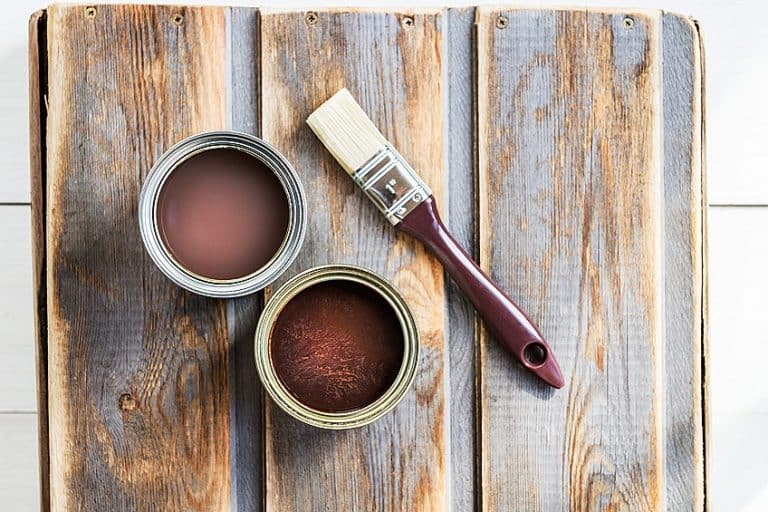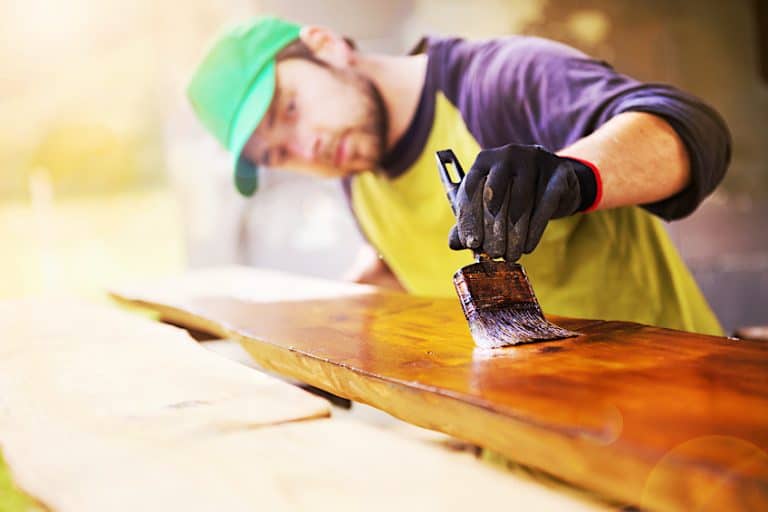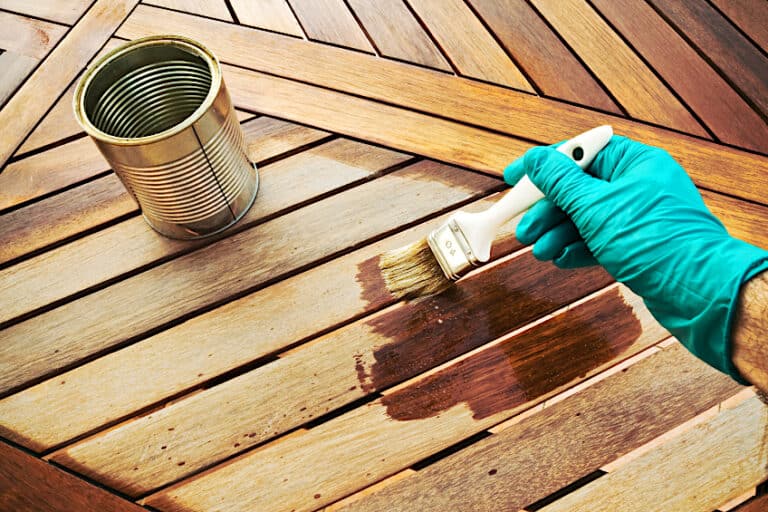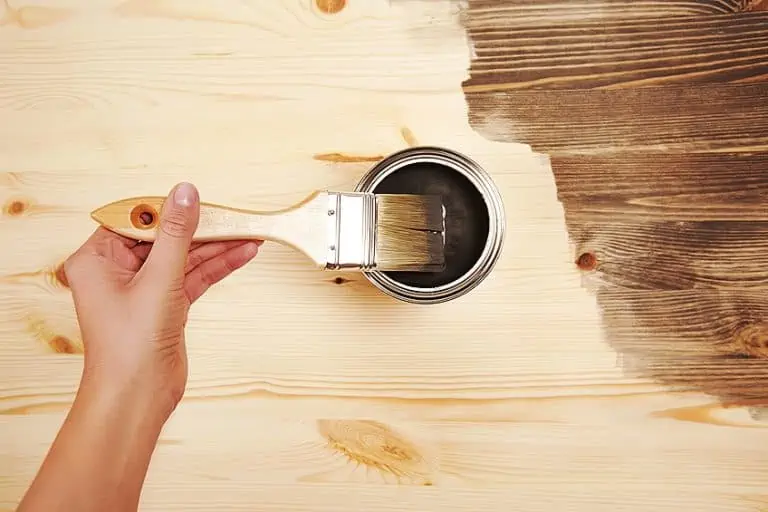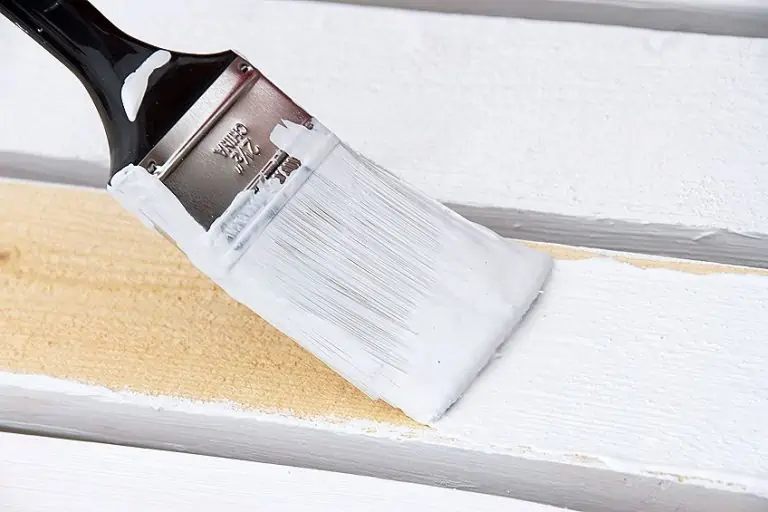Best Paint for Wood – All About Paints for Wooden Surfaces
The first question that pops up when we think about trying to improve the appearance of wood is what is the best paint for wood? While wood typically adjusts to any type of paint for wood, it is important that you know all about the painting process before you actually start painting.
Deciding What Kind of Paint to Use on Wood
The type of wood you are painting will have a great influence on the type of paint you should use. Some woods will need to be prepared before you can apply a coat of paint, whereas others will require specific paints so as to ensure good adhesion between the paint and the wooden surface.
Painting Bare Wood
For wooden surfaces that have never been touched with a paintbrush or dipped in varnish or paint, water-based latex paints work well. When applying water-based latex paint, opt for paint with a glossy finish. Using water-based paints ensures that wooden surfaces can be cleaned easily thereafter. It also guarantees the durability of the furniture pieces. If furniture remains untouched, you can also use latex type paint for wood which will produce a flat finish.
Before you even apply a specific type of paint for wood, sand the wood using sandpaper. A 60- to 80-grit paper works well especially when you are sanding. There is a specific sanding technique you need to follow which ensures your sanding is commanded by wood grain direction. Vacuum surfaces first before you actually wipe the surface down, which can be done by using a damp cloth or tack cloth to remove deadwood.
It is advisable to start preparing the wooden surface to adhere to the paint with a great type of stain-blocking primer. A reason why experts start with a primer base is to minimize the bleeding of the wood. The oil in the wood reacts with the paint during application which causes a bleeding effect on surfaces. While it is advisable to begin by using a good primer, you may be the type of person who is against having the primer stains showing up through a paint job. In that case, decide to cover only the flaws in the wood with primer before painting.
Applying Paint to Finished Wood
Experts in the wood field advise wood painters to settle for oil-based types of paint for woodwork, especially when applying paint to furniture that is used frequently. The reason as to why experts find the oil-based paint alternative so appealing is because of the durability it offers. It is also adhesive to furniture without the need for a primer to be applied first. Certain oil-based types of paint can directly be applied to shellac painted surfaces as well.
The only setback when using oil-based types of paint for wood is that it takes fairly long to harden and cure. Water-based paint finishes wood with a faster drying time. Furthermore, the oil-based type of paint for wood is not as easy to apply. You require chemical solvents (turpentine and mineral spirits) to clean surfaces and brushes. Also when working with oil-based paint, allow for cross-ventilation to prevent feeling overwhelmed by the fumes that are given off by this type of paint for wood.
When it comes to applying a coat of paint on furniture that has already been finished, using a degreaser is a good idea. A degreaser will take off any pre-existing dirt and oil on the wooden surface to produce an evenly finished wooden surface.
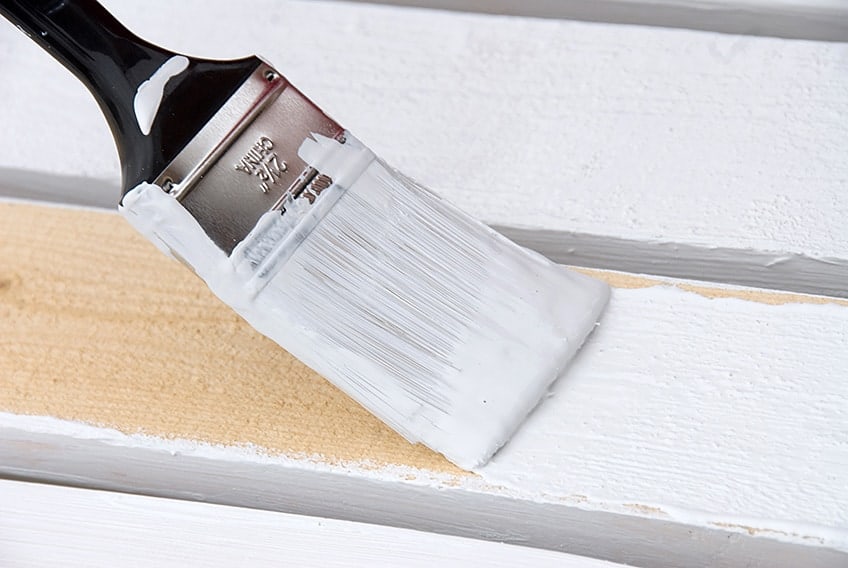
Pressed Wood Furniture Types
What exactly is pressed wood furniture? Furniture that has been crafted from plywood or medium-density fiberboard (MDF) is termed “pressed wood furniture” as it is covered by a wooden smokescreen. This furniture mimics the look of wooden antiques. What is the best type of paint to use on wooden surfaces that are of the pressed wood type? Before you even paint, make sure the pressed wooden surface is subtly laminated.
You need to be careful not to over-laminate as you don’t want to expose the material underneath the paint. Start by sand-laminating the surface carefully. If you are not gentle when you laminate, you are at risk of seeing the surface of the wood. The wooden smokescreen is rather thin, so over-laminating could result in damaging the wooden veneers entirely.
We would advise you to begin with an oil-based primer. An oil-based primer adheres well to surfaces and allows for the best base for paint. Allow for an optimal curing time for the primer before you go ahead and sand. Always sand very gently before adding paint. To find out if your primer is dried, consult the application guidelines on the primer can. It is best to wait at least 24 hours for the primer to dry fully before you apply a layer of paint. It is also ideal to use latex paint over pressed wooden furniture.
Applying Paint to Wooden Furniture
When trying to determine what the best paint for wood is, you need to know from the onset what type of finish you would like to achieve. To create a distressed finish, chalk-type and milk latex paints are good to use. Many people love the milk-latex paint finish on furniture, the reason for which is that the paint seeps into paint cracks, provoking a weathered appearance that is suitable for sideboards and dressers.
For a more solid finish, chalk paints work well. You can control how much chalk paint distresses the surface, especially when it is used on wooden items like tables. The type of paint you choose determines the outcome, so it is advisable to decide on your desirable finish first.
Based on this ideal, a softer finish will be achieved with an oil-based paint. Using oil-based paint on tables and chairs can result in a quick-drying, attractive finish. With oil-based paints, the paints are so durable that you are far less likely to experience dents on the painted furniture after a while.
Painting Wooden Floors
You might be contemplating what kind of paint to use on wooden floors, as it is possible to use a certain type of paint for this particular surface. We recommend that you buy a strong paint type so that your painted floors can endure your constant walking over it. You need to think very practically about what type of paint for wood floors will be best.
The experts suggest opting for latex paint that provides a glossy finish. It does not need to be overly glossy; a semi-gloss finish looks good too. A softer finish will make cleaning these floors effortless. You simply need to use a mop or broom to clean the wooden floor.
Sometimes the latex option won’t be the most desirable option for you. In that case, use oil-based paint types for wood and thereafter add a polyurethane topcoat. The polyurethane topcoat will allow the paint to adhere to your wooden floor and also make sure that your floor doesn’t experience any wear and tear. When applying paint and polyurethane, give your floor enough time to dry so as to ensure you don’t walk on a sticky floor.
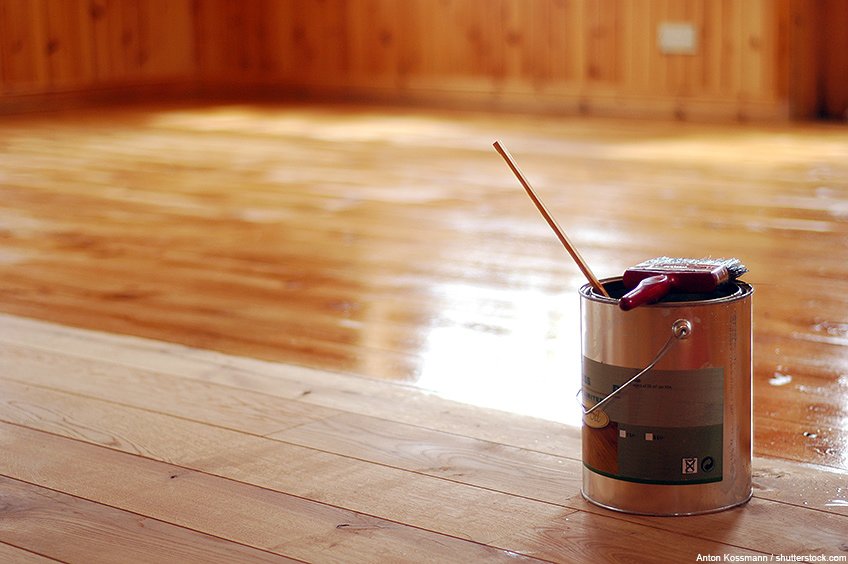
What Paint to Use on Wood?
There are a variety of paint types from which to choose when painting a wooden surface. Some types of paint will be more suitable to your particular project than others, so it is important to do your research so as to achieve the best possible finish.
Acrylic Types of Paint for Wood
You are most likely to use acrylic craft paint for woodwork projects. The acrylic paint type is the best type of paint for wood projects that are artsier. The advantage of the acrylic paint type is that it dries quickly and does not have a smell when you paint with it. For smaller artsy projects, it is ideal as there are many different paint colors and each paint type can produce a different finish. You can even create your own quirky colors or obtain a spectacular ombre-colored finish when you use acrylic paint.
One of the reasons as to why we recommend acrylic paints for projects is because these paints are available in various sizes and types. The same brush you use for painting with acrylic paints can be reused. You must wash these brushes immediately so you can always reuse them again.
Best Paint for Wood: Arteza Acrylic Paint Kit
The Arteza Acrylic Paint of 60 colors is a simple kit that allows you to produce excellent paint finishes on wood. There are so many colors to choose from. You can also blend different colors and this paint kit works as one of the best types of paint for wood. The benefit of this paint type is that its colors are not toxic and are of an extremely high quality. Since many people are uncertain about what kind of paint to use on wood that is in no way toxic, it is good to know that the ACMI has stated that this paint is safe to use. The color kit contains an array of quality intense colors that can be used for any wooden surface.
- Rich, Vivid Pigments guarantees smooth, highly pigmented color
- These colors won’t fade over time and are very sturdy
- Certified Safe & Non-Toxic, they’re ACMI-certified
We recommend that this palate be purchased by both novices and regular painters. The colors are solid and do not wear off easily once the paint has been applied.
Latex Paint Types for Wood
We know that many beginner painters choose to use latex paint, as they find it the easiest to paint with. While oil-based paints are harder to use, they are far more long-lasting. The latex alternative means that the paint will not be as long-lasting. Also, with a latex finish, there is a chance that you will be able to trace paintbrush marks. To eliminate the visibility of paintbrush stains, add the Floetrol substance into the paint. While latex is one of the best paint types for wood, the type of finish that you wish to create will determine if you add anything over the paint or not. Do not add a topcoat after if a glossier finish is what you desire. To gain a matte-like finish or a satin-looking wood surface, one must add a topcoat.
When people ask what kind of paint to use on wood, experts reply that latex paint is best because these paints are easily cleaned.
Best Latex Type: Rust-Oleum Painter’s Touch
What type of paint to use on wood for a glossier finish? Try the Rust-Oleum Painter’s Touch to get this particular finish. The paint is an acrylic type that is water-based. If you are looking to add some shine to your surfaces in an instant, then this might be just the paint for you. It seems as if this is the best paint to be applied to wood in comparison to plaster. One can use this paint for a much larger surface area because of how quick-drying the formula is. It has been mentioned several times that this is one of the quickest and best paints for wood. In this particular range of paints, there are many different colors to choose from.
- Use for a variety of indoor and outdoor surfaces
- Water-based acrylic formula, low odor, provides long-lasting protection
- Covers up to 120 sq ft and dries in 30 minutes
The Oil-Based Paint Type
Most people are quite familiar with the oil-based paint type. We know it because it promises to coat your wooden surfaces for a long period of time. We also often vouch for the oil-based paint, labeling it as one of the best paints for wood due to the luxurious finishes that it creates. From matte finishes to glossier surfaces, oil-based paints are the best type of paint to provide these finishes. With many types of oil-based paints, a shine is naturally accomplished once we add a topcoat.
It is ideal to apply oil-based paint using a good paintbrush rather than painting with a roller. Ask experts for advice on which type of paintbrush is most suitable for painting the oil-based paint. Try not to paint on surfaces that have been painted on already with latex paint. It is best to apply oil-based paint to surfaces that have been untouched by a paintbrush or on a surface that primer has been applied to.
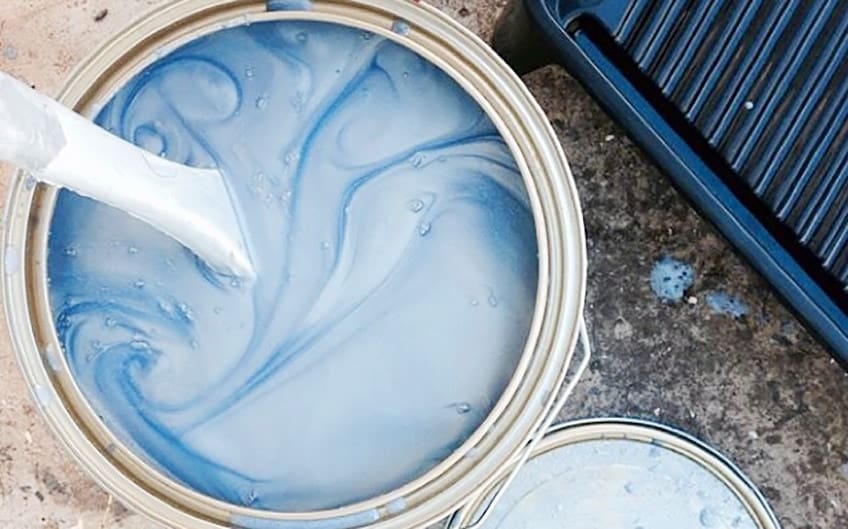
Best Oil-Based Paint: Rust-Oleum Spray Paint
This Rust-Oleum Universal All Surface Spray Paint allows for a shiny finish for all wooden surfaces. We often want a type of paint for wood that produces just the right amount of shine. If this is the case, a rule of thumb to remember when working with this spray paint is that the amount of sheen is dependent on the color chosen.
- Provides an attractive, rich, shimmering metallic look on surfaces
- Oil-based formula with excellent adhesion, prevents rust, long-lasting finish
- Fast-drying formula dries to the touch in 30 minutes
The Rust-Oleum Spray Paint has an oil-based formula that is responsible for the gloss finish that it produces. Being oil-based in nature makes it slightly more long-lasting and adds to its appeal as a paint type.
Chalk Paint: A Unique Antique Finish
There is no easy way to answer the question of what kind of paint to use on wood. The answer is determined by the type of finish you wish to achieve. Water-based paints produce a more antique-like finish that is matte in nature and rather attractive. The reason milky paints like the Chalk Paint can achieve a distressed finish is that it is a formula that easily fills in cracks, allowing for that flaky-yet-distressed look. It makes this type of paint for wood especially desirable when the wooden furniture is the main feature in a room.
It must be remembered that this chalk paint is less distressing, thus offering you added control when you are working on surfaces. So, while this chalk paint is still an excellent choice for a distressed finish, it produces a more subtle and slightly archaic effect. It is advisable to use this paint type for wooden headboards, cupboards, or coat racks.
The Renaissance Chalk Furniture Paint
This Renaissance Chalk Furniture and Cabinet Paint is, as the name suggests, a type of chalk paint that dates back to the Renaissance era. This paint type for wood has earned its popularity from frequently being used for decorative purposes. It is safe to use this paint, as it has an environmentally friendly formula. It is known as a decorative best paint for wood solely because of the finish it offers. People who opt for this brand of paint recommend it to others because of how versatile it is. There is barely a customer who is dissatisfied when they make the purchase.
- Superior coverage - Usually 1 to 2 coat - no sanding or priming required!
- Non-toxic, zero VOC’s, Safe to use indoors
- Specifically designed for furniture and cabinets, silky smooth chalky finish
For a more rustic or bohemian-style look on wooden surfaces, perhaps settle for this type of paint.
What to Do When Painting Wooden Furniture?
If you are one of the few that choose to paint because of how joyfully relaxing the art is, rest assured that we find it relaxing too! When it comes to painting, beginners must remember that the first paint stroke is the most daunting, but once you splash on just the right amount of paint, you can easily do a great paint job. You may think that you have to establish what paints to use on wooden surfaces first before you decide how to start painting the surface. This assumption is wrong. The size of the furniture and its shape actually will determine what kind of paint to use on the wood.
For painting a living room coffee table, you may consider taking a durable type of paint for exterior wooden surfaces. This will ensure the painting job goes faster and enables a quicker drying time. The key rule of painting is to place an old sheet or cloth under the object being painted to avoid splashes of paint in unwanted places.
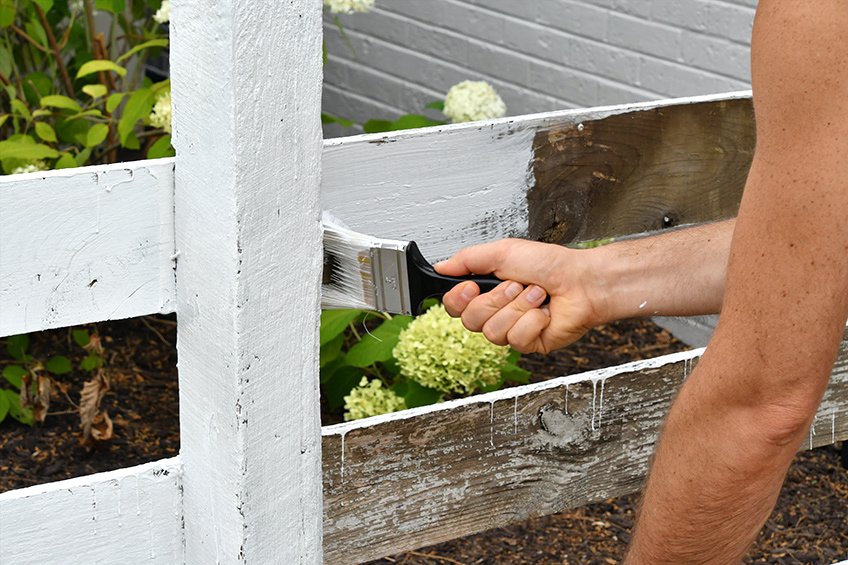
We advise that you use paint that comes in a spray can of some sort to ease the painting task. An airless paint sprayer is effortless to use and requires you simply to point the sprayer towards your wooden surface and spray. For older wooden furniture, you may notice a few scratches here and there. Pick up a scratch pen to get rid of surface scratches. This is a valuable buy as it reduces the amount of paint you will need to use.
While spray cans of paint are advisable, many types of paint come in larger cans. To paint from the can, you will need a paintbrush. For furniture painting, we suggest that you choose a big can of paint due to the larger sized surface area that you are painting. A paintbrush will make it easier to paint a larger surface area too. While the painting is a simple process, do not rush the painting job. If you attempt to speed up the process, your finish may not be as glamorous as expected.
Removing Paint from Wooden Surfaces
Removing or stripping paint from a wooden surface can be done in several ways. The truth is that irrespective of how durable paint is, it does not last for an eternity on a surface. The method you choose to strip the paint will determine the cost incurred.
Almost all paint stripping methods require you to get some objects from the hardware store. If your main concern is getting the paint off and you are not worried about harming your furniture, you can use a sander. Products that grind paint are also options. You can use heat guns to ease off paint layers, after which you can use a hand tool.
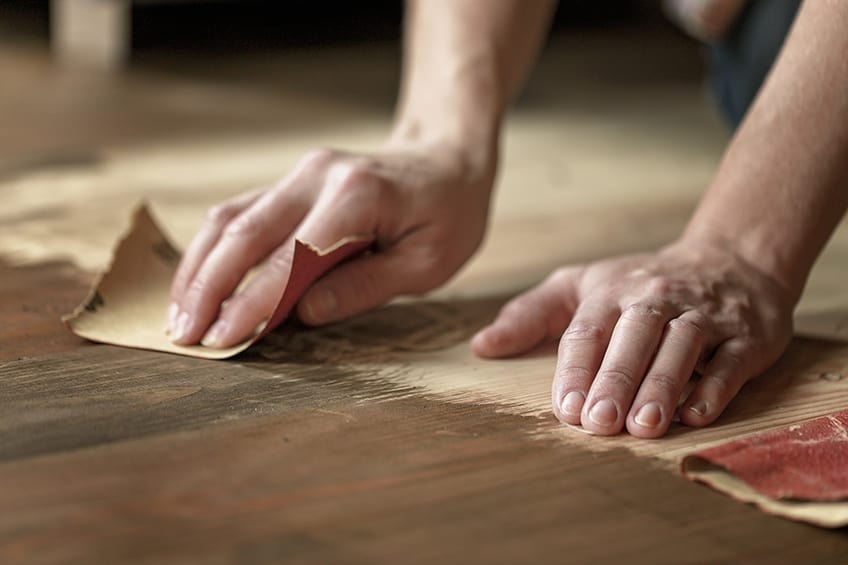
FAQ’s
Does Oil-Based Paint Finish the Wood?
Yes, it is safe to use an oil-based paint to finish wood. Wooden surfaces take well to water-based and oil-based paint alternatives. You must, however, apply a primer on the surface first before painting with an oil-based paint type. There are so many oil-based and water-based types of paint for woodwork to achieve painted finishes on wood that you will be conflicted as to what paint to use on the wood.
Is Oil-Based Paint the Best Type of Paint for Wood Because it Seals?
We recommend oil-based paints for all types of wooden surfaces simply because it does the job of sealing the surface. These paint types stop tannins from being released from wood types. This also prevents the bleeding of wood in certain types like redwood or cedarwood.
Before Using Oil-Based Paint, Must You Prime the Wood?
Even though oil-based paint acts as a sealer, the seal provided by a primer ensures the wooden surface does not soak up too much paint. For many wood types like redwood or cedarwood, it is essential to apply an oil-based primer initially. This will seep deeply into the wooden surface preventing marks from occurring when the wood is painted thereafter.
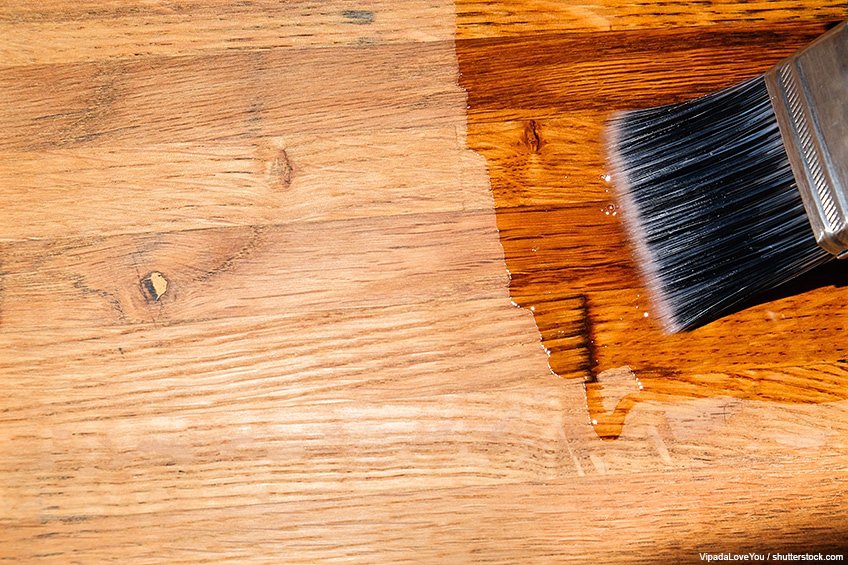
Can You Seal Oil-Based Paint?
To seal oil-based paint, consider starting with a thinner as your first coat of paint. This means that you will need to use six polyurethane coats to one mineral spirits coat when it comes to oil-based and water-based paints. Use a paintbrush to paint lines on the wood. To achieve a desirable finish, brush in an up-to-down motion to complete a full paint stroke. Always use more than one paint coat. Follow the guidelines on the paint can.
How Can I Determine if a Surface was Painted with Oil-Based Paint?
Use a Q-tip drenched in alcohol to check. If the Q-tip removes the paint when you rub it left-to-right on a wooden surface, it means latex paint was used. Oil-based paints are durable and hence will be stubborn to come off. This oil-based painted surface will then require an oil-based primer before paint is added to the surface.

I have been into woodworking since 2005 and woodturning since 2011. Because of my love for wood and woodworking, I started woodhappen.com to teach other enthusiasts about how to finish and seal wood, the best woodworking tools, the different types of wood, and everything else related to woodworking! Read more about me here.






